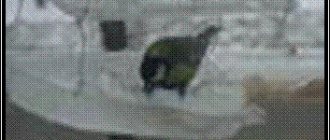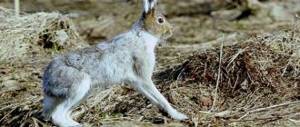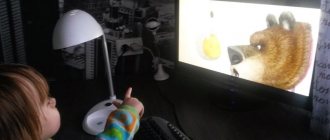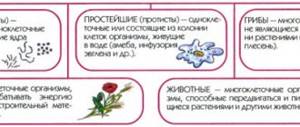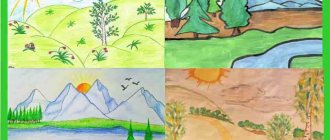Project for children of the senior group on the topic “Fauna and flora of their native land”
Project in kindergarten for children of senior preschool age “Fauna and flora of their native land.”
1)
The author of the project is Yu.A. Deryagina. 2) Project type – Long-term. 3) Type of project - Educational. 4) Project participants - teachers of the MBDOU “Smile”, parents, employees of the Vodlozersky National Park. 5) Form of implementation - direct educational activities, examination of illustrations in encyclopedias and fiction, conversations, thematic consultations for parents on this topic, excursions. 6) Venue – Onega, Arkhangelsk region. 7) Dates – September – May 2020 -2018. Children’s age is 5-6 years. 9) The product of the project is an exhibition of crafts “Autumn Fantasy”, a presentation “Journey through the Northern Forest”, the creation of an album “The Red Book of the Arkhangelsk Region”, a didactic game “Whose leaf?” Expected results - Children will expand and deepen their knowledge of the flora and fauna of their native land through all types of activities. Relevance of the topic: A preschooler learns the laws of nature for the first time. What happens first, what happens next. How living and inanimate nature are interconnected and interdependent. What time do migratory birds arrive? when animals give birth to babies; where do insects come from, what plants and trees grow on planet Earth; What are ecosystems? Children receive basic knowledge from observations, experiments, conversations and, of course, during direct educational activities in kindergarten. Unfortunately, modern children, especially “northern” children, have very limited opportunities to communicate with nature. Children know the plants and animals of other countries quite well and are much worse than those who live next to them. Based on this, a goal was set. Goal: To expand and deepen children’s knowledge about the flora and fauna of their native land. Foster a caring and friendly attitude towards nature. Objectives: - Formation of children’s general ideas about the forest as an ecosystem; formation of ideas about animals and plants as elements of a specific ecosystem; enrichment of vocabulary in children. — Development in children of curiosity, a desire to learn as much as possible about the nature of their native land; development of attention, memory, thinking, coherent speech. — Development of a humane, emotionally friendly and caring attitude towards the surrounding world; the formation of the idea that man is part of nature, that he must preserve, protect and defend it. This methodological development of the project can be useful for preschool teachers, deputy heads. on water resources management, as well as all those who deal with the problem of environmental education of preschool children. Project implementation plan: GCD: “Forest - ecosystem”, “Animals of the Arkhangelsk region”, “Flora of the native land”, “Our friends - birds”, “Life of the White Sea”. Didactic games: “Who gives the voice?”, “Name the animal by description”, “One is many”, “What grows where”, “Collect a plant”, “It is possible or it is not possible.” Conversations: “Native Prionezhye”, “Take care of nature!”, “Gifts of the northern forest”. SCD for modeling “Animals of the North”. GCD for drawing “Birds are our friends.” GCD for the application “White water lilies - transparent dewdrops”. Excursion to the Vodlozersky National Park Participation in the regional photo exhibition “Birds outside my window” Participation in the international event “March of Parks 2018”. Preparatory stage. — Collection of information about the flora and fauna of the native land. — Collection of reference and fiction literature on this topic. — Organization of search activities of children and parents to collect information about animals and plants listed in the “Red Book” of the Arkhangelsk region. — Design of card diagrams for educational games. Making feeders for the “Birds outside my window” photo contest. Main stage. -Educational conversations on the topic of the project. Reading stories about nature G. Ya. Snegirev “Who Plants a Forest”, “Stories about Nature”. G. A. Skrebitsky “Forest Voice”, “White Fur Coat”. -Reading poems. N. Rubtsov “Birches”, “Bear”. -Excursion to the Vodlozersky National Park to the photo exhibition “Birds outside my window.” -View the presentation “Journey through the Northern Forest.” The final stage. -Collective work on sculpting “Animals of the North”. -Holding an exhibition of crafts made from natural materials “Forest Tale”. -Making applications of water lilies using the origami technique. -Creation of the album “Red Book of the Arkhangelsk Region”. -Development and production of the panel “Osprey – Bird of the Year” as part of participation in the “March of the Parks” campaign. Conclusion. Having set for ourselves the goal of this project - to expand and deepen the knowledge of older children about the flora and fauna of their native land through all types of educational activities, we achieved positive results. Children began to take great interest in the nature of their area. We learned about endangered species of flora and fauna in the Arkhangelsk region, and about the rules of behavior in nature. Applications to the project.
6) Venue – Onega, Arkhangelsk region. 7) Dates – September – May 2020 -2018. Children’s age is 5-6 years. 9) The product of the project is an exhibition of crafts “Autumn Fantasy”, a presentation “Journey through the Northern Forest”, the creation of an album “The Red Book of the Arkhangelsk Region”, a didactic game “Whose leaf?” Expected results - Children will expand and deepen their knowledge of the flora and fauna of their native land through all types of activities. Relevance of the topic: A preschooler learns the laws of nature for the first time. What happens first, what happens next. How living and inanimate nature are interconnected and interdependent. What time do migratory birds arrive? when animals give birth to babies; where do insects come from, what plants and trees grow on planet Earth; What are ecosystems? Children receive basic knowledge from observations, experiments, conversations and, of course, during direct educational activities in kindergarten. Unfortunately, modern children, especially “northern” children, have very limited opportunities to communicate with nature. Children know the plants and animals of other countries quite well and are much worse than those who live next to them. Based on this, a goal was set. Goal: To expand and deepen children’s knowledge about the flora and fauna of their native land. Foster a caring and friendly attitude towards nature. Objectives: - Formation of children’s general ideas about the forest as an ecosystem; formation of ideas about animals and plants as elements of a specific ecosystem; enrichment of vocabulary in children. — Development in children of curiosity, a desire to learn as much as possible about the nature of their native land; development of attention, memory, thinking, coherent speech. — Development of a humane, emotionally friendly and caring attitude towards the surrounding world; the formation of the idea that man is part of nature, that he must preserve, protect and defend it. This methodological development of the project can be useful for preschool teachers, deputy heads. on water resources management, as well as all those who deal with the problem of environmental education of preschool children. Project implementation plan: GCD: “Forest - ecosystem”, “Animals of the Arkhangelsk region”, “Flora of the native land”, “Our friends - birds”, “Life of the White Sea”. Didactic games: “Who gives the voice?”, “Name the animal by description”, “One is many”, “What grows where”, “Collect a plant”, “It is possible or it is not possible.” Conversations: “Native Prionezhye”, “Take care of nature!”, “Gifts of the northern forest”. SCD for modeling “Animals of the North”. GCD for drawing “Birds are our friends.” GCD for the application “White water lilies - transparent dewdrops”. Excursion to the Vodlozersky National Park Participation in the regional photo exhibition “Birds outside my window” Participation in the international event “March of Parks 2018”. Preparatory stage. — Collection of information about the flora and fauna of the native land. — Collection of reference and fiction literature on this topic. — Organization of search activities of children and parents to collect information about animals and plants listed in the “Red Book” of the Arkhangelsk region. — Design of card diagrams for educational games. Making feeders for the “Birds outside my window” photo contest. Main stage. -Educational conversations on the topic of the project. Reading stories about nature G. Ya. Snegirev “Who Plants a Forest”, “Stories about Nature”. G. A. Skrebitsky “Forest Voice”, “White Fur Coat”. -Reading poems. N. Rubtsov “Birches”, “Bear”. -Excursion to the Vodlozersky National Park to the photo exhibition “Birds outside my window.” -View the presentation “Journey through the Northern Forest.” The final stage. -Collective work on sculpting “Animals of the North”. -Holding an exhibition of crafts made from natural materials “Forest Tale”. -Making applications of water lilies using the origami technique. -Creation of the album “Red Book of the Arkhangelsk Region”. -Development and production of the panel “Osprey – Bird of the Year” as part of participation in the “March of the Parks” campaign. Conclusion. Having set for ourselves the goal of this project - to expand and deepen the knowledge of older children about the flora and fauna of their native land through all types of educational activities, we achieved positive results. Children began to take great interest in the nature of their area. We learned about endangered species of flora and fauna in the Arkhangelsk region, and about the rules of behavior in nature. Applications to the project.
"Whose leaf"
Literature: 1. N. E. Veraksa, T. S. Komarova, M. A. Vasilyeva. From birth to school - M.: Mosaic - Synthesis, 2020. 2. Familiarization with nature in kindergarten. Senior group. – M.: Mosaic – Synthesis, 2020. 3. Voronkevich O. A. Welcome to ecology! Senior group. Part 2. – St. Petersburg. “Childhood - Press”, 2020. 4.. Zebzeeva V. A. Theory and methods of environmental education for children. Educational and methodological manual. - M., 2009. 5. Serebryakova T. A. Environmental education in preschool age - M., 2008. 6. Physical education / comp. S. A. Levina, S. I. Tukacheva. - V.: Teacher, 2005.
We recommend watching:
Project in kindergarten for older preschoolers 5-7 years old on legal topics Creative project in kindergarten “Wild and Domestic Animals”. Senior group Educational creative project in the senior group on the topic: Insects Project on the theme “Russian folk tales” in kindergarten in the senior group
Similar articles:
Project for children of the senior group “Our cheerful garden”
Poems about pets for children 5-6 years old
Coloring pages “Wild animals” for children 5-7 years old
About the beaver for children 6-7 years old
A story about a monkey for children 6-7 years old
Didactic guide-lapbook “Plants and animals of the native land”
Valentina Kartavaya
Didactic guide-lapbook “Plants and animals of the native land”
Good afternoon, dear colleagues, dear jury.
They say that a teacher must keep up with the times, and sometimes be a little ahead of it, showing his creativity and imagination. In connection with the introduction of the Federal State Educational Standard for preschool education, every teacher is looking for new approaches and ideas in their teaching activities. One of these ideas in my case was the creation of a lapbook. This new, interesting manual was liked not only by me, but also by my kids. A laptop is multifunctional - this is why it is useful in work; using it, children can be told, shown, repeated and consolidated material on a chosen topic. What is a laptop?
In one of the interpretations it sounds like this: “Lapbook”
– a thematic folder –
a “book on the knee”
– an effective teaching tool and a form of joint activity between adults and children.
For children, these are bright, multifunctional folders with many pockets, windows, little books, pictures that you can not only look at and play with, but also create your own new game. For educators, this is a great way to collect the necessary minimum of information on a chosen topic in one place, limited only by your imagination in design.
The idea of creating my own folder seemed very interesting to me. And I got to work. The first thing I did was decide on the topic “ Plants and Animals of the Native Land ”
, why this particular topic?
Working on the environmental topic of our region , I encountered difficulties that children and even some parents do not know their region , in particular what trees, animals , insects live in our area. A laptop, in my opinion, will help solve this problem.
I present to your attention my work, my first trial lapbook “ Plants and Animals of the Native Land ”
It took me longer to decide on goals and objectives.
Goal: To consolidate and expand children’s knowledge about the flora and fauna of their native land . Develop a caring attitude towards nature and all living things .
Objectives: Expand and systematize knowledge about the flora and fauna of our region ;
Develop cognitive activity, curiosity, communication skills; attract interest in the nature of the native land ;
Instill a friendly attitude towards the animal and plant world ;
To cultivate a sense of pride, love, empathy and respect for the nature of the native land .
This didactic manual is intended for children of middle preschool age . This is an interesting, indispensable teaching aid , which has a bright design, a clear structure, interestingly designed material - various developmental and creative tasks are “hidden”
in pockets. By completing tasks with the help of drawings, games, punched cards, the child learns new things in an easy and relaxed manner, makes observations, consolidates and improves his knowledge on a certain topic.
Cardboard boxes were used as the basis . Each page is covered with environmentally themed pictures printed on a color printer. The edges of the pages are finished with decorative tape. The cover is covered with foamirana. I connected the pages together in the form of a clamshell book. The subject folder consists of (includes)
8 pages: 6 pages with tasks, 2 pages are laptop covers.
Each page contains various educational and creative tasks “hidden”
in pockets.
On the first page there is an interactive panel “Forest”
.
At the top of the page there is a figured envelope with a drawstring, which contains flat figurines of wild animals .
Options for games that can be offered to children: D/i “Who Lives in the Forest”
— systematize children’s understanding of wild
animals living in the Bryansk region; D/I “Guess who?”
- where one child describes or makes a riddle, and the other must guess and name what kind of
animal it , place it on the panel; D/I “Who has who?”
— learn to name
animals and their cubs , use the genitive case of singular and plural nouns.
On the next page there are two didactic games and riddles about plants and animals of our native land .
D/I “Ecological assortment”
— cut-out pictures depicting
plants and animals of their native land . Children assemble a picture from the parts, name what is depicted and which group it belongs to (insects,
animals , birds, trees) D/I “The Fourth Wheel”
or
“What’s missing”
- with the help of a smiley, the child closes the extra one and, on the contrary, guesses what is hidden behind the smiley. These games develop children's memory, thinking, concentration, and observation skills.
The riddles are in the cloud-shaped notebook at the top of the page.
The third page contains information about trees and mushrooms. There is a pocket with a set of environmental cards “Trees”
.
Children get acquainted with the structure of a tree, learn what each part of the tree is needed for (root, trunk, branches)
. Options for playing with cards:
“What trees do you know”
,
“Lay out coniferous and deciduous trees”
,
“What are the similarities and differences between trees”
.Goal: to expand and enrich children’s knowledge about trees, to familiarize them with their
growth , similarities and differences. With the help of the game “What’s the beginning, what’s next,”
which is located in a small accordion book on the left, children get acquainted with the development cycle of a tree.
At the top of the page there is a rotating element in the shape of a circle, with a didactic game “Which tree is the leaf from?”
—
to contribute to the expansion of knowledge about the trees of our strip.
Ensure the development of children's ability to select leaves from trees. Fix with the children the names of the trees and the appearance of the leaves. Information about mushrooms is presented in a notebook with pages of varying lengths. Here children can get acquainted with the variety of mushrooms and identify groups of edible and inedible ones. Tell children about the beneficial properties of inedible mushrooms - they are dangerous to humans, but they are a medicine for some animals and serve as a home for some insects. Teach children how to pick mushrooms correctly.
The next page is dedicated to “Nature Conservation”
.
This element is made against a wood background in the form of a figured opening envelope. Environmental symbols are depicted on the inside of the envelope. Using signs, explain to children why the rules are what they are and what will happen if they are broken. To reinforce the rules of behavior in nature, I offer children environmental cards depicting correct and incorrect behavior in nature, which I placed behind the opening element in the form of a fence, at the bottom of the page. The child examines the cards and determines which prohibiting sign applies to it. Here on this page I have placed the game “Who Lives in the Meadow?”
.The purpose of the game: to expand and consolidate children’s knowledge about insects characteristic of our area.
On the next spread, in the shaped pockets, I placed three educational games .
D/I "Puzzles"
- assemble a picture from parts, write a short story based on the picture.
D/I “Catch a Fish”
— introduce children to the fish that live in our reservoirs.
D/I “Paired pictures”
(memory)
. Rules of the game: cards are laid out
face
down on the table. In turn, each player opens any two cards, showing them to everyone. If they show the same drawings, he takes them for himself and opens the next pair. If the images are different, then he returns these cards face down back to their places, and the turn passes to the next player. When all the cards have been sorted out, the winner is chosen - the one who collected the most cards.
At the top of the page I placed an element in the shape of a sun, on the rays of which proverbs and sayings about their native land . Purpose: to introduce children to proverbs and sayings about their native land , learn them by heart, and explain the meaning. On the right in the small pocket you can see a card index of finger games for the development of fine motor skills.
Next, the child finds himself in the world of insects and birds. In the shaped pockets you can see pictures of insects and birds. Flashcards will help you formulate the concept of “insects”
,
“birds”
. Purpose: to teach children to recognize and name the birds of our
region ; expand and consolidate knowledge about insects of their native land .
At the bottom of the page there are two transparent pockets with a teaching aid . In one of the pockets I placed the manual “The Red Book”
, which contains information about
the animals of the Bryansk region . Purpose: to study rare species of animals found in the Bryansk region.
Explain to children that the “Red Book”
, this is a symbol of anxiety and turning to people for help. It is necessary to protect the living planet with the diversity of life forms that were given by nature itself.
In another pocket there is a “Green Pharmacy”
- medicinal
plants . Purpose: to introduce medicinal plants of the native land , how they are used, what benefits they bring to humans.
This manual is a means of developmental learning. A laptop is an excellent way to obtain , expand and consolidate knowledge to familiarize children with the environment, namely with animals and plants of their native land . Didactic manual lebuk “ Plants and animals of the native land ”
It is recommended to use it when organizing different types of educational activities: in independent activities, in joint work of a teacher with children, in individual work.
Designed for group and individual work in a kindergarten group. This is a good way to reinforce the topic of studying the rules of behavior in the forest, systematize knowledge about animals and plants of your native land , and get acquainted with medicinal plants growing in our area . In addition to educational advantages, a lapbook is perceived by children as a “treasure”
that is interesting to return to. The child simply opens the folder and happily discovers the material covered. Lapbooks are popular with children and they are happy to return to it again and again.
